Such a pathological condition as laryngeal edema can be a symptom of various diseases. The throat can swell as a result of inflammation caused by infectious diseases, allergies, injuries, after being in a room with very dusty or polluted air. Despite the fact that the symptom is the same, each case requires an individual approach to treatment that will help eliminate discomfort in the throat.
The reasons
A large number of different factors can cause throat swelling. In order to understand the swelling in the throat, what it is and why it occurs, it is necessary to find out the main reasons provoking the swelling. Among the main factors are:
- inflammatory processes of the nasopharynx;
- allergy to the use of drugs, drinks, food;
- damage to the throat by foreign objects, such as fish bones;
- thermal burn with too hot liquid or air;
- exacerbation of severe chronic diseases such as tuberculosis or syphilis;
- x-ray examination of the cervical spine;
- various infectious diseases such as measles, scarlet fever, influenza;
- various kinds of neoplasms in the nasopharynx, for example, papillomas;
- disturbances in the work of the circulatory system caused by compression of veins or lymphatic vessels;
- inflammatory processes of cartilage in the nasopharynx.
Important! Pathologies of the cardiovascular system, abnormalities in the functioning of the kidneys and liver can also often be the cause of laryngeal edema.
Laryngeal edema is most often a sign that pathological processes are taking place in the body. In the vast majority of situations this symptom occurs as a result of inflammation that develops in the tissues of the pharynx. Provided that the swelling of the throat is caused by a viral or bacterial infection, most often the pathological process will be associated with inflammation of the tonsils and laryngeal mucosa. Allergic reactions are accompanied by pronounced swelling of the throat mucosa, as well as symptoms such as lacrimation, rhinitis, hyperemia of the skin of the face.
Symptoms
Any of the possible causes of laryngeal edema corresponds to a number of symptoms that help specialists make the correct diagnosis and prescribe effective treatment. If the throat is swollen, there are a number of common signs that are characteristic of this disease:
- painful sensations when swallowing in the area of \u200b\u200bthe mucous throat, which resemble the symptoms of tonsillitis;
- the neck may hurt, the pain is aggravated when the head is turned;
- signs of body poisoning: the patient complains of a headache, fever;
- hoarseness, change in voice;
- the neck may swell, part of the face may swell;
- hyperemia, in which it swells;
- feeling of a foreign object in the throat;
- annoying dry cough.
When a person is just starting to get sick, it is difficult to recognize the cause, since among the main symptoms there are insignificant discomfort and shortness of breath. As the pathology develops, pain occurs, which increases when swallowing food, since edema helps to narrow the lumen in the throat.
In the later stages, edema can cause an attack of suffocation, which is extremely dangerous for a person's life.
Also dangerous is the situation when the swelling spreads to the mucous surface of the vocal cords. In this case, the above symptoms become more pronounced. The swelling may increase, with the growth period often taking several hours to several days, depending on the cause of the symptom. In this case, you should immediately consult a doctor.
If a person is in a very dusty room for a long time or inhales air in which various kinds of irritants are present, this can cause an allergic reaction of the body. Most often, allergies cause swelling, redness, swelling. If the throat is affected, breathing may be difficult. Also, allergization of the body is often accompanied by increased salivation, lacrimation, rhinitis.
In the case when laryngeal edema is not accompanied by allergy symptoms, elevated temperature and other symptoms characteristic of most diseases, it can be caused by various kinds of injuries. For example, eating too hot or cold food, getting into the nasopharynx of chemicals (alcohols, vinegar, various kinds of acids), damage to the mucous membrane of the throat (scratches, wounds) when swallowing solid food, all this can cause swelling of the throat.
- A chemical burn of the larynx is the most dangerous cause of pharyngeal swelling. In this case, the patient experiences severe pain throat, swelling. After recovery, rough scars remain on the pharyngeal mucosa, which, narrowing the esophagus, complicate food intake and breathing.
- Thermal burns of the larynx occur most often after eating too hot food or drinks. In this case, the patient experiences a burning sensation in oral cavity and pharynx, the mucous membrane is hyperemic and edematous, depending on the severity of the burn, erosion and ulcers may occur. If scarring occurs, there is a possibility of breathing problems.
- Mechanical damage to the throat, leading to its swelling, can occur due to foreign objects entering the throat. If the injury affects the laryngopharynx area, it can cause a choking attack.
Important! If your throat is swollen, excessive alcohol consumption may be the cause. In this case, the disease may also be accompanied by swelling of the face, edema of the extremities.
Puffiness in the throat after drinking intoxicants indicates that an excessive amount of fluid has accumulated in the tissues, as well as the functioning of the excretory system and the blood supply system is impaired.
Diagnostic methods
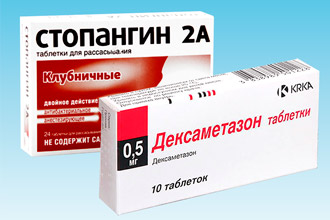 In order to prescribe the correct and effective treatment, it is necessary to determine the causes of the disease. Therefore, a number of diagnostic procedures should be carried out, which are most often based on a detailed examination and questioning of the patient. In this case, consultation with an otolaryngologist, phoniatrist or ENT surgeon is most often required.
In order to prescribe the correct and effective treatment, it is necessary to determine the causes of the disease. Therefore, a number of diagnostic procedures should be carried out, which are most often based on a detailed examination and questioning of the patient. In this case, consultation with an otolaryngologist, phoniatrist or ENT surgeon is most often required.
The main procedures that doctors carry out in case of difficulty breathing:
- laryngoscopy (direct and indirect) of the larynx;
- bronchoscopy - a procedure for examining the mucous membranes of the trachea and bronchi using an endoscope;
- x-ray of the pharynx area;
- tomography;
- a general blood test and an analysis for immunoglobulins to determine the type of pathogenic microorganism and exclude allergies.
In order to determine the causes of the swelling of the throat, doctors often use instrumental diagnostics for diagnostic purposes. These methods include:
- Microlaryngoscopy - used to determine the presence of a foreign object in the throat, the presence of a tumor, scars, neoplasms that can provoke difficulty breathing. Within the framework of this method, endoscopic biopsy and histological analysis are also used to determine possible changes in the nasopharynx.
- Study of the functions of the vocal cords. This method includes phonetography, stroboscopy and electroglottography. It is carried out with edema of the vocal cords to determine the degree of their mobility and general condition.
- Computer and magnetic resonance imaging, ultrasound examination of the thyroid gland, x-rays of the lungs are also effective ways to determine the cause of the edema.
Treatment
After analyzing the symptoms of the disease and carrying out diagnostic procedures, you can find out the cause that caused the unpleasant symptom. Treatment of throat edema is primarily aimed at reducing the severity of the symptom, minimizing pain and normalization of breathing.
In order to prevent the occurrence, as well as reduce the likelihood of developing infectious diseases, doctors recommend:
- good nutrition;
- drinking a sufficient amount of fluid (at least 2 liters per day);
- control of temperature and humidity in the room (20-22 degrees Celsius and 50%, respectively, are considered optimal);
- irrigation of the nasopharynx with saline solutions.
Unilateral throat swelling
If the throat is swollen on only one side, then most often a similar symptom indicates the presence of a viral or bacterial infection, when pathogenic microorganisms are localized only on one side of the pharynx.
With tonsillitis, asymmetric edema is often observed, while the one-sidedness of the inflammatory process is also noticeable from the face.
Also, among the reasons that cause swelling of the throat on only one side, mechanical damage to the mucous membranes of the pharynx can be distinguished. Stuck fish bones, swallowing sharp objects, solid food, all these can cause one-sided edema.
Methods for diagnosing and treating unilateral sore throat will be similar to those used for bilateral swelling of the laryngeal mucosa. Effective therapy will be based on an analysis of the causes of the disease.
Glands (tonsils) are an important part of the immune system, an organ that helps fight viruses, infections, and resists the spread of pathogens.
The main task of the glands is to identify the infection in time, to develop antimatter to fight pathogenic microorganisms. Acting as a barrier, often the tonsils in people swell, because they are the first to take the blow.
What to do if the tonsils are swollen, how to treat them at home in order to recover as soon as possible?
Swollen glands with painful sensations
If it hurts a person to swallow, his glands are swollen, then this may indicate such diseases as:
- angina;
- pharyngitis;
- acute tonsillitis;
- retropharyngeal abscess.
Angina is characterized by the following symptoms: fever up to 40 degrees, difficulty swallowing, sudden chills, weakness, malaise.
With pharyngitis (inflammation back wall pharynx) there is a runny nose, cough, redness of the tonsils, general malaise, fever up to 39 degrees.
Acute tonsillitis is characterized by reddening of the tonsils, the appearance of purulent plaque, an increase in the cervical lymph nodes, and fever.
With a retropharyngeal abscess, the patient complains of a nasal voice, hoarseness, shortness of breath, blue skin, swelling of the neck, attacks of suffocation.
Angina - inflammation of the tonsils
 In order to calm sore glands, relieve swelling, it is necessary to disinfect and soothe the irritated surface.
In order to calm sore glands, relieve swelling, it is necessary to disinfect and soothe the irritated surface.
For this purpose, you can resort to help:
- rinses;
- inhalations;
- warming up;
- compresses;
- drinking medicinal liquids.
If your throat hurts, then you need to treat it comprehensively... To do this, you should definitely take the drugs prescribed by your doctor, use traditional medicine, if necessary, resort to physiotherapy.
Rinses
This method of treating swollen glands is used in the case of diagnosing sore throat, pharyngitis or laryngitis. The rinsing process soothes inflamed tonsils, helps to remove pus-filled plugs, swelling, and pain.
 The following recipes are suitable for rinsing:
The following recipes are suitable for rinsing:
- Furacilin solution... Dissolve 1 tablet in a glass of warm water. Gargle a swollen throat 3 times a day.
- Iodine solution... Add 3 drops of iodine to a glass of water. Rinse every 40 minutes.
- Apple vinegar... Mix 1 tbsp. l. vinegar in a glass of water. Rinse sore throat such a remedy up to 5 times a day.
- Honey with lemon juice... Take 1 tbsp. l. liquid honey, dilute it with freshly squeezed lemon juice (1 tbsp. l.). Dilute the mixture with a little water, rinse 3 times a day.
Inhalation
This method of treating swollen tonsils is permissible only if the disease is not accompanied by an increase in body temperature.
Hot steam warms up the throat well medications penetrate deep into the pharynx, affect the focus of infection. As a result, not only pain disappears, but swelling of the tonsils is also eliminated.
Prescriptions of medicinal solutions for inhalation:

Inhalation helps to quickly relieve swelling of the tonsils, destroy pathogens, moisturize the mucous membrane, suppress inflammation in the pharynx, and also increase local immunity.
Warming up
Not sure what to do if your tonsils are swollen? Try to warm up your throat. Just be careful: often this method of treating inflamed tonsils can provoke the spread of the inflammatory process to other parts of the pharynx and even internal organs.
Warming up should only be done after a doctor's approval.
 However, it is thanks to this method of therapy that the swelling can be quickly reduced and the sore throat relieved. The following methods are used for warming up:
However, it is thanks to this method of therapy that the swelling can be quickly reduced and the sore throat relieved. The following methods are used for warming up:
- wrap warm sea salt in a clean cloth. Attach the bag to the throat in the area of \u200b\u200bthe tonsils;
- warming up the whole body: steam your feet in hot water with the addition sea \u200b\u200bsalt or mustard powder;
- wrapping the throat with a warm scarf, in parallel with this, putting on woolen socks on the legs.
In order to quickly remove the swelling of the tonsils, it is necessary to disinfect and soothe the irritated throat. For this it is useful to ingest honey, onions, garlic, ginger, propolis.
Compresses
Compresses will help to quickly cope with swollen glands:

Keep the compresses all night long.
If the throat hurts, the swelling does not go away after home treatment for a week, then this is a reason to contact the ENT. After a thorough examination, the appointment of laboratory tests, the specialist must prescribe a course of intensive therapy.
Liquid intake
Most often, the tonsils swell as a result of pathogens entering the pharynx. To remove them as soon as possible, you need to take a lot of fluids:
- warm milk;
- tea with lemon or raspberry jam;
- decoctions of medicinal herbs: chamomile, mint, sage, rose hips. You need to drink at least 2 liters a day. This will help to quickly relieve puffiness;
- warm fruit drinks, juices, compotes.
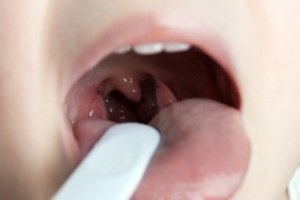 What to do if the gland is swollen on one side and what does this mean?
What to do if the gland is swollen on one side and what does this mean?
Unilateral inflammation of the tonsil is not uncommon, and an indicator that the infection is still in a small area of \u200b\u200bthe larynx, the human immune system does not allow it to spread further.
The tonsil on the one hand can swell with diseases such as flu, pharyngitis, laryngitis, tonsillitis.
Also, such an unpleasant phenomenon can happen to a person who has received a mechanical injury, for example, a bone from a fish is stuck in the lymphoid tissue.
If the throat does not hurt, but the tonsils are swollen, then this means that the patient has either chronic tonsillitis or a fungal infection of the tonsils.
Symptoms of chronic tonsillitis:
- an increase in the size of the tonsils, a loose structure of the glands;
- swelling of the palatine arches;
- the appearance of "plugs" - white clusters, pus with an unpleasant odor.
If swollen glands are observed in a child without pain, then, as a rule, his cervical lymph nodes also increase, the temperature may slightly rise, and his voice may change. Also, the child may develop problems with breathing and swallowing, he often begins to hurt.
People suffering from chronic tonsillitis often have weakness, drowsiness, increased fatigue, and low efficiency.
Treatment of chronic tonsillitis at home is aimed at the use of immunostimulating drugs, vitamins, local antiseptics in the form of rinsing:
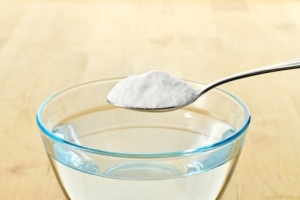
During rinsing, pathogenic microbes are washed out of the lacunae of the tonsils.
Speaking about the fungal infection of the tonsils (mycosis of the larynx), you should first accurately determine the disease. Many doctors often confuse a fungal infection with a bacterial or viral infection.
For a correct diagnosis, the patient must pass laboratory tests (sowing tank from the throat).
Symptoms of a fungal infection of the tonsils:
- feeling of dry mouth;
- sore throat;
- the appearance of a cheesy plaque on the mucous membrane.
The enlargement of the glands with a fungal infection usually goes away without fever.
Treatment of mycosis of the larynx is carried out with the obligatory use of antifungal agents, for example, tablets "Nystatin", "Fluconazole", "Clotrimazole", etc. As for local treatment, local antiseptic agents are used to eliminate swelling of the tonsils.
Gargling is carried out by using solutions such as "Chlorhexidine", "Miramistin"... They flush the inflamed glands, have an antiseptic effect.
The tonsils can also swell as a result of mechanical irritation of the mucous membrane. This is due to:
Prevention
So that the tonsils no longer swell, turn red and hurt, you must adhere to the following recommendations:
- Increase the body's defenses: lead a healthy lifestyle, temper, eat right, give up bad habits, play sports, do exercises every day.
- Avoid provoking factors: do not overcool, dress for the weather, do not drink cold drinks, ice cream, humidify the air in the room.
- Treat promptly chronic diseases: sinusitis, runny nose, caries.
- In autumn and winter carry out preventive throat rinsing.
Before treating swollen glands, the cause of the problem must be determined. Otherwise, it may worsen again, complications will appear and then, perhaps, even surgical intervention may be required.
At home, to remove puffiness, inflammation of the tonsils will help such techniques as rinsing, inhalation, warming the throat, compresses.
From time to time, most people have to deal with swelling of the throat, the etiology of which can be both inflammatory and non-inflammatory. Therefore, if the throat is swollen, it will not be superfluous to visit the hospital, because the swelling of the throat can cause more serious symptoms - paroxysmal cough and difficulty breathing. It is extremely important that the treatment of edema is not only symptomatic, but consists in identifying the cause and, if possible, its absolute elimination.
In this article, we will talk about why the throat swells, in what diseases it can swell and how to help a person if the throat is swollen.
To determine the reason why the throat is severely swollen, one must not forget that edema is not an independent disease, but just a symptom. Localization of edema, its extent and the presence of pain depends on various factors, including the individual structure of the subcutaneous fat and mucous membranes.
The most common reasons are:
- foreign bodies of the respiratory system;
- inflammatory infectious or viral etiology;
- burns of the mucous membrane;
- allergic reactions;
- exposure to radiation therapy or x-rays;
- infectious diseases.
In order to establish the cause of the edema, it is necessary to consult a doctor. The instruction, which is guided by a specialist for conducting diagnostic studies, includes pharyngoscopy and laryngoscopy - procedures necessary to examine the throat and assess the degree of swelling.

Clinical manifestations
Any reason why the throat hurts and swells has its own characteristic symptoms. In order to figure out what was the impetus for the appearance of this symptom, you need to more specifically consider all possible situations.
So:
- are dangerous injuries that damage the lining of the throat. A burn can occur when exposed to hot food or drinks, chemicals, and is often accompanied by burns not only to the throat, but also to the mouth and esophagus. Most often, burns occur in a domestic environment, during suicide attempts, in production, during self-medication. It is not uncommon for young children to find household chemicals, for example, to clear blockages or ordinary vinegar, and drink it.
Burns are accompanied by increased salivation, nausea and vomiting, fever, and a burning sensation in the throat. In addition, with a burn, the throat is sore and swollen, with burns chemicals there is a specific odor from the mouth, in severe cases it reaches a state of shock.
Depending on the severity of the burn, bubbles may form on the mucous membrane, covered with grayish films, which, bursting, leave behind scars; or else the tissue affected by the burn dies off, with the formation of scabs and ulcers. After these elements heal, scars remain in their place, which interfere with the normal functioning of the larynx, pharynx and esophagus.
- Foreign bodies quite often pose a serious threat to human life. Most often they occur in young children, due to their age, babies can swallow small objects or toys, which can cause complete or partial obstruction of the airways.
In the manifestation of symptoms, the origin of a foreign body plays an important role, for example, if it is a bone, a needle, or another object with sharp protrusions, it can pierce the mucous membranes, as a result of which, during diagnosis, it will be noticeable that the throat is swollen inside, and a reflex cough, arising in such cases, can aggravate the condition by moving the foreign object deeper into the thickness of the tissues.
In addition, shortness of breath, hoarseness or aphonia (loss of its sonority), painful sensations, panic and fear may occur, in severe cases - cyanosis of the skin and mucous membranes in the area of \u200b\u200bthe nasolabial triangle and stenosis of the larynx.
- Diphtheria is sharp infectious disease, which causes an inflammatory process in the area where the pathogen has settled. Previously, it was believed that only children are exposed to this disease, but recently an increase in diphtheria has been noticed in people under 40. Diphtheria can be complicated or uncomplicated and take the following forms:
- non-toxic (in vaccinated patients);
- subtoxic (with moderate intoxication);
- toxic (severe intoxication and swelling of the neck);
- hemorrhagic (severe intoxication, bleeding, death);
- hypertoxic (fulminant intoxication, death in 2-3 days).
The disease is accompanied by a sore throat and difficulty swallowing, tickling, coughing, redness and sore throat. A couple of days after the onset of the disease, grayish fibrinous films are visualized at the site of introduction of the pathogen, which are difficult to separate, and when trying to remove them, they cause bleeding.
The throat is swollen, with a more severe course of the disease, you can notice that the throat is swollen outside, so much so that in some cases the swelling can reach the collarbones. In addition, with diphtheria, a feeling of weakness and general malaise is expressed, the body temperature rises to 40 ° C, drowsiness, headache, pallor and tachycardia are present.
- Scarlet fever also used to be considered an exclusively childhood infectious disease, but very often adults also suffer from it. The causative agent of scarlet fever is beta-hemolytic streptococcus belonging to group A. Scarlet fever can be infected by alimentary, household or airborne droplets. The disease proceeds in one of the possible forms:
- erased;
- toxic-septic;
- extrabuccal.
In more than half of cases in adults, the disease is diagnosed in an erased or toxic-septic form. With scarlet fever, there are bright red rashes on the body, sore throat, you can also notice that the throat is swollen inside, it became painful to swallow.
Blood pressure decreases, the limbs become cold, patients feel weak and are in a fainting state.
Note! The toxic-septic form of scarlet fever can lead to complications such as myocarditis or endocarditis, pneumonia, arthritis, otitis media or pyelonephritis.
Help with throat swelling
Many are interested in what to do if the throat is swollen (see), is it worth going to the doctor, how serious the treatment will be, and it may still be possible to do without folk methodscooked with your own hands?
In fact, if everything were so simple, then soon the profession of a doctor would disappear as unnecessary. But in fact, it should be understood that only a specialist can make the correct diagnosis, as well as assess the severity of the disease and choose the right treatment.
For each disease, a treatment instruction is individually selected, in some cases assistance must be provided immediately, when the price of every minute is incredibly high before the ambulance team arrives.
Table 1: Treatment tactics for throat edema in different cases:
Disease Treatment Burns Application of cold compresses, injections of calcium chloride, novocaine, sedatives, diphenhydramine, antibiotic therapy, specialized diet Foreign bodies Try to remove a foreign object by grabbing the person from behind and pressing sharply with your fists above the navel, removing foreign bodies endoscopic methods in the hospital Quincke's edema Allergen elimination, cold compresses, epinephrine injections, antihistamines and glucocorticosteroids Angina Gargling with soda solution and antiseptic drugs, plentiful warm drinks (especially warm milk with butter or honey), pain relievers, antipyretics, antibiotics Laryngitis Compliance with the silence regime, abundant warm drinks, steam inhalation and gargling, compresses on the neck Diphtheria The use of anti-diphtheria serum, antihistamines, plasmapheresis, glucocorticoids, rheopolyglucin, antibiotic therapy, inhalations with mineral waters Scarlet fever Drinking plenty of fluids, antipyretics, antibiotics, antihistamines, gargling with herbal decoctions or furacilin From the photos and videos in this article, we learned why the throat swells and what it is fraught with, considered some of the diseases in which this symptom occurs and got acquainted with the tactics of their treatment.
Often, inflammation is accompanied by swelling of the larynx. How to relieve throat swelling, what are the causes of the symptom, how to diagnose and treat it.
It is known to be rarely an independent disease. Most often, it indicates the development of various pathological processes in the human body. Moreover, this condition is extremely dangerous, as it can lead to suffocation with a rapid increase in swelling and narrowing of the lumen in the larynx. In this case, you need to know what to remove in order to quickly restore breathing. In the treatment of throat edema, both medicinal methods and methods of traditional medicine are used. In order to find the most effective treatment, it is necessary to determine the causes of the pathological condition.
The reasons
Various factors, both inflammatory and non-inflammatory, can cause swelling. To understand how to relieve throat swelling, you should analyze possible reasons the appearance of an unpleasant symptom. So, soreness and swelling in the throat can be caused by:
- laryngitis;
- tonsillitis;
- inflammation of the oral mucosa;
- purulent inflammation of the base of the tongue;
- allergic reactions to drugs, food;
- abnormalities in the work of the kidneys, liver, organs of the cardiovascular system;
- problems with blood circulation in the pharyngeal region as a result of excessive compression of the lymph nodes;
- mechanical damage during surgery, mucosal burns.
To assign the correct and effective treatment with swelling in the throat, you should know not only the causes, but also the main symptoms of the disease.
Symptoms
Among the main signs of edema are:
- soreness when swallowing saliva and food;
- dry, sore throat;
- noisy breathing;
- difficulty breathing, as a result of increased swelling and narrowing of the throat;
- hoarseness leading to complete loss of voice.
As the pathological process aggravates, the swelling increases, shortness of breath appears, pallor of the skin, rapid heart rate, and a feeling of panic may be observed.
On visual inspection in the area of \u200b\u200bedema, a thickening of the epiglottis is noticeable, and the swelling can also spread to the arytenoid cartilage.
Puffiness caused by inflammatory processes, characterized by pronounced redness of the mucous membrane, vasodilation. Whereas edema of a non-inflammatory nature is not accompanied by hyperemia.
Treatment
If the patient experiences a feeling of tightness and a sore throat, he should be given immediate assistance to quickly relieve the swelling of the throat and restore breathing.
Important! If first aid for laryngeal edema is not provided in time, there is a risk of complications, development of asphyxia and suffocation.
How to treat throat swelling? Until qualified medical care, you can reduce the swelling yourself.
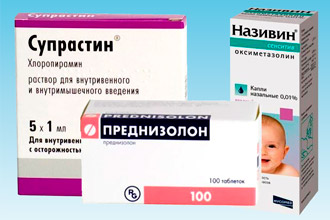
Inpatient treatment is primarily aimed at performing procedures that will relieve puffiness and restore breathing. In this case, treatment can be carried out both conservatively and with the use of surgical intervention.
Conservative therapy includes a set of measures aimed at quickly normalizing the patient's condition and restoring full breathing. For this, the following drugs are used:
- antiallergic agents;
- antibiotics (Augmentin);
- corticosteroids;
- diuretics (Furosemide);
- intravenous administration of vitamin C, calcium gluconate and glucose to support the body;
- sedatives and tranquilizers (Apaurin, Diapam).
Also, inhalations with adrenaline and hydrocortisone are used as a treatment, oxygen masks are used.
If conservative methods of treatment have not yielded a positive result and the swelling not only does not decrease, but continues to progress, you should know what to do with throat swelling in this case. Most often, doctors resort to emergency surgical measures - tracheotomy. This is an incision in the throat where a tube is inserted to allow air to enter the airway without obstruction.
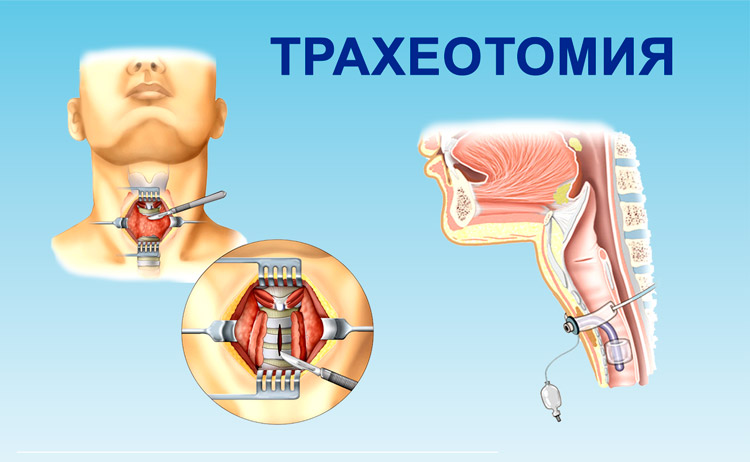
During the entire period of treatment, some precautions should be taken, adhering to the following recommendations:
- follow a diet - eat exclusively warm food in a liquid or puree-like state, completely excluding any seasonings and spices;
- exclude intense physical activity, brisk walking;
- reduce the load on the ligaments and speech apparatus.
Treatment with folk remedies
If the swelling in the throat does not cause severe discomfort and difficulty breathing, you can try to reduce the discomfort at home using alternative medicine methods.
- Gargle with baking soda solutions (1 teaspoon in a glass of warm water) and decoctions of medicinal herbs, such as chamomile, calendula. If you are not allergic, you can add a few drops of an essential oil, such as eucalyptus, to the soda solution. It is necessary to repeat the rinsing procedure several times a day until the swelling, perspiration and pain in the throat completely disappear.
- A cold compress applied to the throat can help reduce swelling caused by noncommunicable diseases. It could be a heating pad with cold water or pieces of ice wrapped in a towel.
- Inflammation and swelling in the pharynx can be reduced with honey and carrot juice. It is necessary to use a freshly prepared solution three times a day, at least 100 ml at a time.
- You can remove excess fluid from the body and reduce edema with the help of a rosehip decoction, which has a pronounced diuretic effect. To do this, a tablespoon of rosehip berries is brewed in a liter of boiling water, infused for several hours and consumed during the day for half a glass.

